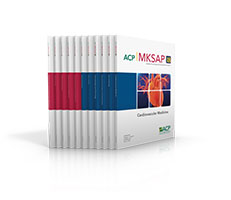 MKSAP has been trusted by internists since 1967 as the best resource for updating knowledge. MKSAP 18, available in Complete, Digital, and Print packages, consists of 11 comprehensive text chapters with related multiple-choice questions. You'll find 1,200 completely new questions to help you identify learning gaps, stay current, and gain the knowledge you need to provide the best possible patient care. MKSAP 18's original and high-quality questions evolve out of case studies and patient scenarios based on the latest evidence.
MKSAP has been trusted by internists since 1967 as the best resource for updating knowledge. MKSAP 18, available in Complete, Digital, and Print packages, consists of 11 comprehensive text chapters with related multiple-choice questions. You'll find 1,200 completely new questions to help you identify learning gaps, stay current, and gain the knowledge you need to provide the best possible patient care. MKSAP 18's original and high-quality questions evolve out of case studies and patient scenarios based on the latest evidence.
For more information on MKSAP 18, or to order your copy, visit mksap18.acponline.org.
MKSAP 18 Q & A
A 38-year-old woman is evaluated for a 2-day history of worsening eye pain and decreasing visual acuity in her left eye. The pain is worse with eye movement. She reports no fever or trauma. Vision loss is mostly central, and her ability to distinguish colors has diminished. She does not feel the sensation of a foreign body in the eyes. She wears contact lenses. Her medical history is otherwise unremarkable.
On physical examination, vital signs are normal. Eye movement is intact but painful, with visual acuity of 20/20 in the right eye and 20/60 in the left. Afferent pupillary defect is noted in the left eye. There is no corneal injection or discharge, and the optic discs appear normal.
Which of the following is the most likely diagnosis?
A: Corneal abrasion
B: Herpes simplex keratitis
C: Optic neuritis
D: Orbital cellulitis

